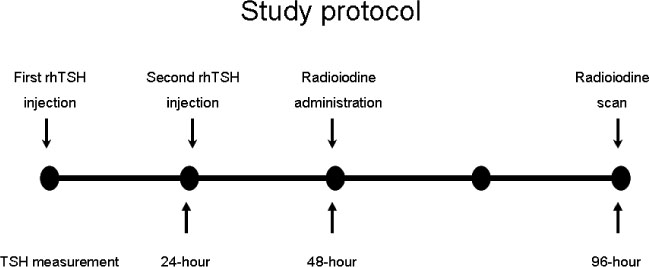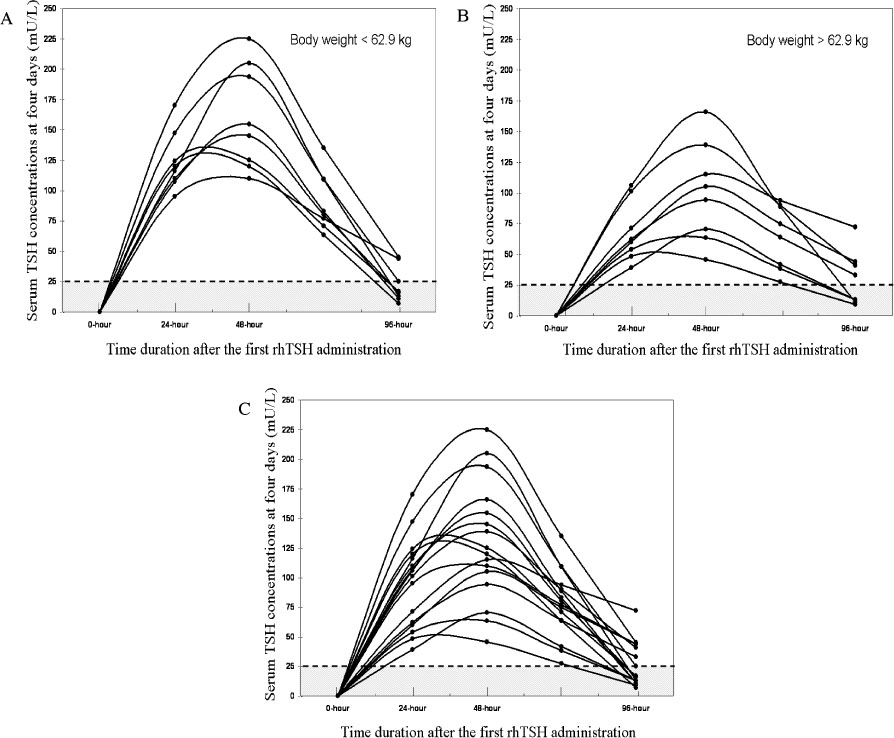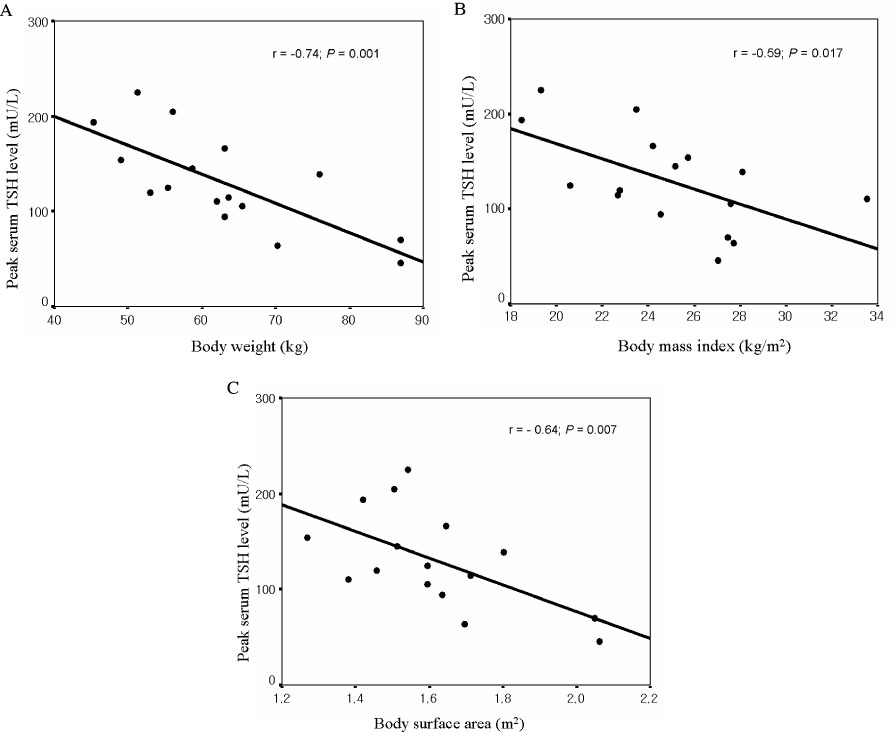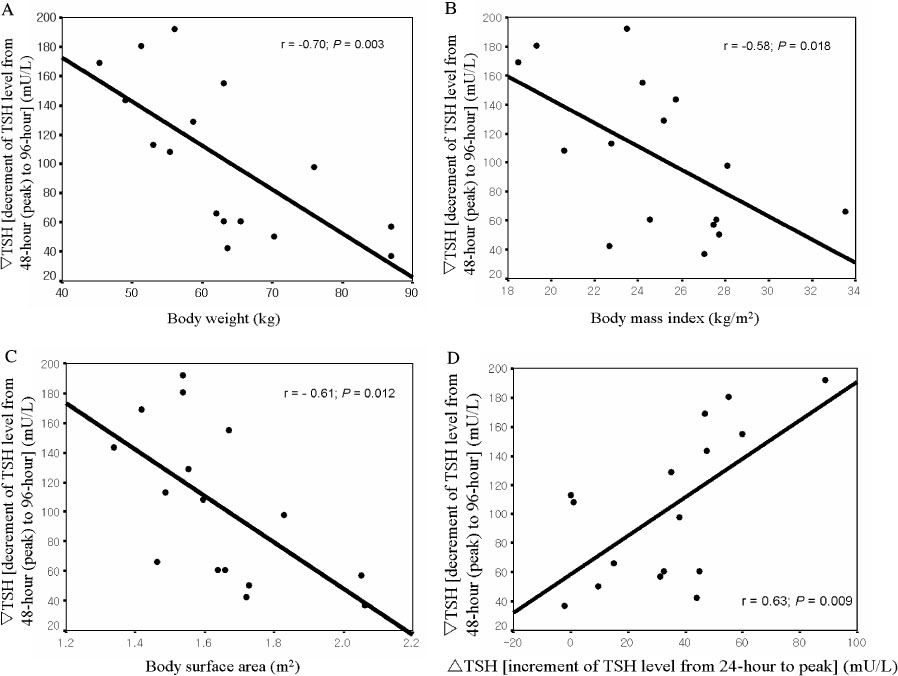J Korean Soc Endocrinol.
2006 Jun;21(3):204-212. 10.3803/jkes.2006.21.3.204.
Analysis of the Pharmacokinetics of Recombinant Human TSH in Patients with Thyroid Papillary Carcinoma
- Affiliations
-
- 1Division of Endocrinology and Metabolism, Department of Medicine, Samsung Medical Center, Sungkyunkwan University School of Medicine, Korea.
- KMID: 2200732
- DOI: http://doi.org/10.3803/jkes.2006.21.3.204
Abstract
-
BACKGROUND: Individual variations of the pharmacokinetics of recombinant human TSH (rhTSH) might influence the efficacy of the radioactive iodine (RAI) uptake. We studied to investigate the individual pharmacokinetics of rhTSH and the effect of the anthropometric parameters on the serum TSH levels in patients with thyroid papillary carcinoma.
METHODS
We selected 16 patients with conventional rhTSH administration for the preparation of RAI administration between June 2004 and May 2005. We measured serum TSH levels at 24-hour (prior to second rhTSH injection), 48-hour (peak level, prior to RAI administration) and 96-hour (prior to scanning) after the first rhTSH injection. We analyzed the correlation of each TSH levels with age, height, weight, creatinine clearance, body mass index (BMI), and body surface area (BSA).
RESULTS
Peak TSH levels were negatively correlated with weight, BMI, and BSA. Among them, weight was an independent parameter by multivariate analysis. Decrement of serum TSH levels from the peak to the level at 96-hour was negatively correlated with weight, BMI, and BSA. It was positively correlated with increment of serum TSH levels from the level at 24-hour to the peak level. Serum TSH level at 96-hour was lower than 25 mU/L in nine of 16 patients.
CONCLUSION
Body weight was inversely correlated with peak TSH level after rhTSH administration. rhTSH-stimulated TSH levels might be exaggerated to unwanted levels, and very rapidly degraded in lower-weighted patients. We should make up for the rhTSH regimen considering the individual variations of its pharmacokinetics.
MeSH Terms
Figure
Reference
-
1. Billewicz WZ, Chapman RS, Crooks J, Day ME, Gossage J, Wayne E, Young JA. Statistical methods applied to the diagnosis of hypothyroidism. Q J Med. 1969. 38:255–266.2. Meier CA, Braverman LE, Ebner SA, Veronikis I, Daniels GH, Ross DS, Deraska DJ, Davies TF, Valentine M, DeGroot LJ. Diagnostic use of recombinant human thyrotropin in patients with thyroid carcinoma (phase I/II study). J Clin Endocrinol Metab. 1994. 78:188–196.3. Luster M, Felbinger R, Dietlein M, Reiners C. Thyroid hormone withdrawal in patients with differentiated thyroid carcinoma: a one hundred thirty-patient pilot survey on consequences of hypothyroidism and a pharmacoeconomic comparison to recombinant thyrotropin administration. Thyroid. 2005. 15:1147–1155.4. Huber GK, Fong P, Concepcion ES, Davies TF. Recombinant human thyroid-stimulating hormone: initial bioactivity assessment using human fetal thyroid cells. J Clin Endocrinol Metab. 1991. 72:1328–1331.5. Wondisford FE, Radovick S, Moates JM, Usala SJ, Weintraub BD. Isolation and characterization of the human thyrotropin beta-subunit gene. Differences in gene structure and promoter function from murine species. J Biol Chem. 1988. 263:12538–12542.6. Haugen BR, Pacini F, Reiners C, Schlumberger M, Ladenson PW, Sherman SI, Cooper DS, Graham KE, Braverman LE, Skarulis MC, Davies TF, DeGroot LJ, Mazzaferri EL, Daniels GH, Ross DS, Luster M, Samuels MH, Becker DV, Maxon HR 3rd, Cavalieri RR, Spencer CA, McEllin K, Weintraub BD, Ridgway EC. A comparison of recombinant human thyrotropin and thyroid hormone withdrawal for the detection of thyroid remnant or cancer. J Clin Endocrinol Metab. 1999. 84:3877–3885.7. Moog F, Linke R, Manthey N, Tiling R, Knesewitsch P, Tatsch K, Hahn K. Influence of thyroid-stimulating hormone levels on uptake of FDG in recurrent and metastatic differentiated thyroid carcinoma. J Nucl Med. 2000. 41:1989–1995.8. Robbins RJ, Tuttle RM, Sharaf RN, Larson SM, Robbins HK, Ghossein RA, Smith A, Drucker WD. Preparation by recombinant human thyrotropin or thyroid hormone withdrawal are comparable for the detection of residual differentiated thyroid carcinoma. J Clin Endocrinol Metab. 2001. 86:619–625.9. Barbaro D, Boni G, Meucci G, Simi U, Lapi P, Orsini P, Pasquini C, Piazza F, Caciagli M, Mariani G. Radioiodine treatment with 30 mCi after recombinant human thyrotropin stimulation in thyroid cancer: effectiveness for postsurgical remnants ablation and possible role of iodine content in L-thyroxine in the outcome of ablation. J Clin Endocrinol Metab. 2003. 88:4110–4115.10. Vitale G, Lupoli GA, Ciccarelli A, Lucariello A, Fittipaldi MR, Fonderico F, Panico A, Lupoli G. Influence of body surface area on serum peak thyrotropin (TSH) levels after recombinant human TSH administration. J Clin Endocrinol Metab. 2003. 88:1319–1322.11. Castagna MG, Pinchera A, Marsili A, Giannetti M, Molinaro E, Fierabracci P, Grasso L, Pacini F, Santini F, Elisei R. Influence of human body composition on serum peak thyrotropin (TSH) after recombinant human TSH administration in patients with differentiated thyroid carcinoma. J Clin Endocrinol Metab. 2005. 90:4047–4050.12. Cockcroft DW, Gault MH. Prediction of creatinine clearance from serum creatinine. Nephron. 1976. 16:31–41.13. Haycock GB, Schwartz GJ, Wisotsky DH. Geometric method for measuring body surface area: a height-weight formula validated in infants, children, and adults. J Pediatr. 1978. 93:62–66.14. Ladenson PW, Braverman LE, Mazzaferri EL, Brucker-Davis F, Cooper DS, Garber JR, Wondisford FE, Davies TF, DeGroot LJ, Daniels GH, Ross DS, Weintraub BD. Comparison of administration of recombinant human thyrotropin with withdrawal of thyroid hormone for radioactive iodine scanning in patients with thyroid carcinoma. N Engl J Med. 1997. 337:888–896.15. Pacini F, Molinaro E, Lippi F, Castagna MG, Agate L, Ceccarelli C, Taddei D, Elisei R, Capezzone M, Pinchera A. Prediction of disease status by recombinant human TSH-stimulated serum Tg in the postsurgical follow-up of differentiated thyroid carcinoma. J Clin Endocrinol Metab. 2001. 86:5686–5690.16. Pacini F, Molinaro E, Castagna MG, Lippi F, Ceccarelli C, Agate L, Elisei R, Pinchera A. Ablation of thyroid residues with 30 mCi (131)I: a comparison in thyroid cancer patients prepared with recombinant human TSH or thyroid hormone withdrawal. J Clin Endocrinol Metab. 2002. 87:4063–4068.17. Mazzaferri EL, Robbins RJ, Spencer CA, Braverman LE, Pacini F, Wartofsky L, Haugen BR, Sherman SI, Cooper DS, Braunstein GD, Lee S, Davies TF, Arafah BM, Ladenson PW, Pinchera A. A consensus report of the role of serum thyroglobulin as a monitoring method for low-risk patients with papillary thyroid carcinoma. J Clin Endocrinol Metab. 2003. 88:1433–1441.18. Park SG, Reynolds JC, Brucker-Davis F, Whately M, McEllin K, Maxted D, Robbins J, Weintraub BD. Iodine kinetics during 131-I scanning in patients with thyroid cancer: comparison of studies with recombinanthuman TSH (rhTSH) vs. hypothyroidism. J Nucl Med. 1996. 37(abstr):15.19. Edmonds CJ, Hayes S, Kermode JC, Thompson BD. Measurement of serum TSH and thyroid hormones in the management of treatment of thyroid carcinoma with radioiodine. Br J Radiol. 1977. 50:799–807.20. McDougall IR, Weigel RJ. Recombinant human thyrotropin in the management of thyroid cancer. Curr Opin Oncol. 2001. 13:39–43.21. Kohlfuerst S, Igerc I, Lind P. Recombinant human thyrotropin is helpful in the follow-up and 131I therapy of patients with thyroid cancer: a report of the results and benefits using recombinant human thyrotropin in clinical routine. Thyroid. 2005. 15:371–376.22. Vargas GE, UY H, Bazan C, Guise TA, Bruder JM. Hemiplegia after thyrotropin alfa in a hypothyroid patient with thyroid carcinoma metastatic to the brain. J Clin Endocrinol Metab. 1999. 84:3867–3871.23. Robbins RJ, Voelker E, Wang W, Macapinlac HA, Larson SM. Compassionate use of recombinant human thyrotropin to facilitate radioiodine therapy: case report and review of literature. Endocr Pract. 2000. 6:460–464.24. Braga M, Ringel MD, Cooper DS. Sudden enlargement of local recurrent thyroid tumor after recombinant human TSH administration. J Clin Endocrinol Metab. 2001. 86:5148–5151.25. Lippi F, Capezzone M, Angelini F, Taddei D, Molinaro E, Pinchera A, Pacini F. Radioiodine treatment of metastatic differentiated thyroid cancer in patients on L-thyroxine, using recombinant human TSH. Eur J Endocrinol. 2001. 144:5–11.26. Giovanni V, Arianna LG, Antonio C, Francesco F, Michele K, Giovanni S, Marco S, Giovanni L. The use of recombinant human TSH in the follow-up of differentiated thyroid cancer: experience from a large patient cohort in a single centre. Clin Endocrinol (Oxf). 2002. 56:247–252.27. Goffman T, Ioffe V, Tuttle M, Bowers JT, Mason ME. Near-lethal respiratory failure after recombinant human thyroid-stimulating hormone use in a patient with metastatic thyroid carcinoma. Thyroid. 2003. 13:827–830.28. Chiu AC, Delpassand ES, Sherman SI. Prognosis and treatment of brain metastases in thyroid carcinoma. J Clin Endocrinol Metab. 1997. 82:3637–3642.29. Kogai T, Endo T, Saito T, Miyazaki A, Kawaguchi A, Onaya T. Regulation by thyroid-stimulating hormone of sodium/iodide symporter gene expression and protein levels in FRTL-5 cells. Endocrinology. 1997. 138:2227–2232.
- Full Text Links
- Actions
-
Cited
- CITED
-
- Close
- Share
- Similar articles
-
- Concurrent Medullay and Papillary Carcinoma of the Thyroid
- Association between Preoperative Serum TSH Level and Papillary Thyroid Cancers
- Risk Factors for Hypothyroidism after Thyroid Lobectomy with Papillary Thyroid Crcinoma according to Existence of Thyroiditis
- Clinical implications of preoperative thyrotropin serum concentrations in patients who underwent thyroidectomy for nonfunctioning nodule(s)
- A Case of Subsequent Papillary Carcinoma of the Thyroid gland and Hashimoto's Thyroiditis





